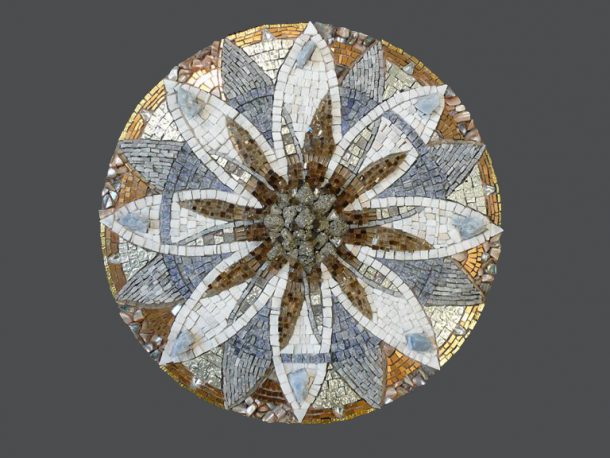This new Mandala exhibition looks fascinating and gives us a great reason to visit Hotlanta!

The Sacred Round: Mandalas by the Patients of Carl Jung, features 40 original mandalas created by the Swiss psychoanalyst’s patients during their treatment between 1926 and 1945. It opened February 5 and runs through May 6, 2012 at the Oglethrope University Museum of Art, in Atlanta, Georgia. This is the first time this work is being exhibited to the public!
Jung used Mandalas as part of his psychoanalytical practice to help his clients express the conscious and unconscious. His groundbreaking work is published the Collected Works, and in 1972 was compiled into the seminal book: Mandala Symbolism, by C. G. Jung, with translation by R.F.C. Hull. Jung painted his first mandala in 1916, but it wasn’t until a few years later that he began to understand how his drawings corresponded to his “inner situation at the time”. He began to use the drawings to observe his psychic transformations, sort of ‘cryptograms’ of the eternal mind. In the subsequent years he began to develop the theory of how working with mandalas can reflect the psychic development of the self.
Employing mandalas into his private practice was a technique for which he was his own “guinea pig,” observing dreams, symbolism, the archetype of wholeness, alchemy, and human nature. Jung was drawing his own mandalas and working secretly on his magnum opus, The Red Book, between 1912 – 1930.
Regarding works of art as symbols, C. G. Jung observed the following:
“Their pregnant language cries out to us that they mean more than they say. We can put our finger on the symbol at once, even though we may not be able to unriddle its meaning. A symbol remains a perpetual challenge to our thoughts and feelings. This is why a symbolic work is so stimulating and also why it grips us so intensely.”
— from “On the Relation of Analytical Psychology to Poetry”
Included in the exhibit is a handmade book containing one patient’s dream descriptions and drawings, hailed as the feminine version of Jung’s now famous Red Book. Jung’s work with his patients was centered around the process of individuation. One of the famous cases studies revolved around “Miss X”, an 59 year-old American woman who was a psychology student herself. Jung worked with her during the 1920’s in Zurich, after she arrived in Europe to seek more information about her ancestry. She was not an artist, but during this time she attempted painting and found extreme contentment with the process, though little ability at first.

Early work by Miss X, from the book: Mandala Symbolism by C.G. Jung
Her paintings are quite beautiful, and in fact show development in both style and facility as the process continued. However, Jung cautions us to pay attention to the early stages of naive work where it can serve as the bridge to integrate deep internal processes toward wholeness:
“…it is important not to skip too quickly over the initial stages. As these picture are intuitive anticipations of future developments, it is worthwhile lingering over them for a long time, in order, with their help, to integrate so many concerns of the unconscious into the consciousness that the latter really does reach the stage it sees ahead. These psychic evolutions do not as a rule keep pace with the tempo of intellectual developments…their very first goal is to bring a consciousness that has hurried too far ahead into contact again with the unconscious background with which it should be connected…”

Mandalas by Miss X, from the book 'Mandala Symbolism', by C.G. Jung
This passage struck me deeply as Jung describes the importance of slowing down, and the usefulness of deep contemplation. Making art, drawing, working with the hands were all important outlets and tools Jung employed to develop groundbreaking therapeutic insights. Through his patient’s mandala work, we see why art can be such a powerful healing tool — it allows the development of our consciousness to catch up, as our internal mind struggles to keep tempo with the ‘primitive state of affairs’ required of survival in a chaotic modern world. Our ‘fight or flight’ mechanisms are soothed by encountering the center.
Vicente de Moura, exhibition curator and curator of the C.G. Jung Institute has put together a very interesting line up of presentations and lectures running through May 2.
On Friday Feb 24th, Mandala: The Natural Center explores the rich field of ideas suggested by both Jungian and Tibetan approaches to the mandala. The presentation is by Atlanta-based Susanne Fincher, whose book “Creating Mandalas” was one of the first mandala books I used to inspire by own mandala practice.
Another intriguing lecture: The Shape of the Life is Round on April 24, with Lloyd Nick, director, Oglethorpe University Museum of Art, will focus on the circle as a symbol of wholeness and the experience of unity from many cultural and art history sources.
More about the related exhibition programs HERE

Miss X, Picture 21, from Mandala Symbolism, C.G. Jung
TRAVEL TIP
a big P.S. – If you’ve worked up an appetite after looking at all those Mandalas, be sure to EAT at RIA’s BLUEBIRD, where you can see my mosaic mural circa 1999, made in collaboration with my partner-in-crime Laurel True. Click here for a PHOTO and more. Ria is serving up everything from BRISKET BREAKFAST to COUNTRY FRIED TEMPEH y’all.
Ria’s Bluebird 421 memorial drive, atlanta ga 30312 riasbluebird.com


Reblogged this on art horses healing and commented:
This exhibit of Carl Jung’s mandalas looks wonderful! Trying to figure out if there’s a time to get to Atlanta, GA before it closes!
Ogelthorpe is great at bringing intriguing art to Atlanta.
thanks for commenting! this show is unique and intriguing and kudos to the O. museum for bringing it!